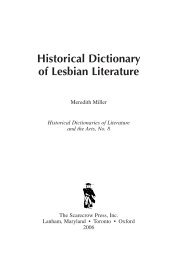Founded by Friends : the Quaker heritage of fifteen - Scarecrow Press
Founded by Friends : the Quaker heritage of fifteen - Scarecrow Press
Founded by Friends : the Quaker heritage of fifteen - Scarecrow Press
Create successful ePaper yourself
Turn your PDF publications into a flip-book with our unique Google optimized e-Paper software.
Haverford College 9<br />
monographs, all <strong>of</strong> which are to be found in <strong>the</strong> <strong>Quaker</strong> Collection at<br />
Haverford. In addition, in 1980, a vast collection <strong>of</strong> Rufus Jones’s manuscripts<br />
was added. An inventory <strong>of</strong> <strong>the</strong> collection reveals <strong>the</strong> variety and<br />
output <strong>of</strong> his mind.<br />
Henry J. Cadbury (1883–1974) was ano<strong>the</strong>r <strong>of</strong> Sharpless’s extraordinary<br />
faculty choices. Cadbury graduated from Haverford in 1903, received his<br />
MA from <strong>the</strong> college in 1904, and was hired to teach Greek, religion, and<br />
biblical literature in 1910. In October 1918, already a well-known scholar,<br />
he wrote a letter to <strong>the</strong> Public Ledger deploring <strong>the</strong> “orgy <strong>of</strong> hate” expressed<br />
in <strong>the</strong> American press toward Germany, stating that <strong>the</strong> American<br />
nation itself was <strong>the</strong> greatest obstacle to peace and least worthy <strong>of</strong> it, that<br />
it lusted for vengeance and blood, while what was needed was moderation<br />
and fair play. Responses from various constituent groups at Haverford<br />
ranged from a request for Cadbury’s resignation to support for his<br />
pacifism and for academic freedom <strong>of</strong> expression. Cadbury left <strong>the</strong> college<br />
but some decades later renewed his ties. On his death in 1974, Haverford<br />
received a collection <strong>of</strong> his papers consisting <strong>of</strong> a wealth <strong>of</strong> articles, books,<br />
book reviews, Bible course notes, extensive correspondence, and lectures.<br />
Isaac Sharpless also brought to campus <strong>the</strong> ma<strong>the</strong>matician Frank Morley.<br />
His three sons, Christopher, Felix, and Frank Vigor Morley, all graduated<br />
from Haverford and were selected as Rhodes scholars. Christopher<br />
Morley reached <strong>the</strong> pinnacle <strong>of</strong> his popularity as a writer in <strong>the</strong> 1930s and<br />
1940s. Erudite, witty, and quintessentially versatile, he probed every literary<br />
genre. By a series <strong>of</strong> gifts, Haverford has acquired one <strong>of</strong> <strong>the</strong> largest<br />
collections (over 3,000 items) <strong>of</strong> Morley manuscript materials extant.<br />
Through <strong>the</strong>se materials, it is possible to glean not only <strong>the</strong> events <strong>of</strong> Morley’s<br />
life and his lifelong interest in Haverford but also, quite evidently,<br />
<strong>the</strong> way in which his mind worked. This is <strong>of</strong>ten most clear in <strong>the</strong> letters<br />
he wrote—and he was a prolific letter writer.<br />
Ano<strong>the</strong>r famous Haverfordian from <strong>the</strong> Sharpless era was <strong>the</strong> artist Maxfield<br />
Parrish, who matriculated at Haverford College in 1888 when art was<br />
not a part <strong>of</strong> <strong>the</strong> curriculum. As a freshman, Parrish was a member <strong>of</strong> <strong>the</strong><br />
“Classical Section” <strong>of</strong> study (<strong>the</strong>re was also a “Scientific Section” and an<br />
“Engineering Section” as well as an undefined or “Special Section”). By his<br />
junior year, Parrish was in <strong>the</strong> Special Section along with six o<strong>the</strong>r members<br />
<strong>of</strong> <strong>the</strong> class <strong>of</strong> 1892. While a student, Parrish was already creating some <strong>of</strong><br />
<strong>the</strong> artwork for which he would become famous. Visitors who have seen<br />
Parrish’s extraordinarily illustrated chemistry notebook from 1890 have<br />
been awed <strong>by</strong> it. No less creative are <strong>the</strong> place cards he made for some classmates,<br />
depicting <strong>the</strong>m <strong>by</strong> <strong>the</strong>ir most striking characteristics, such as “historian”<br />
or “banjo player.” Haverford has received this and o<strong>the</strong>r Parrish materials,<br />
such as correspondence, drawings, and even a guitar decorated <strong>by</strong><br />
Parrish, primarily <strong>by</strong> gifts over <strong>the</strong> years.
















